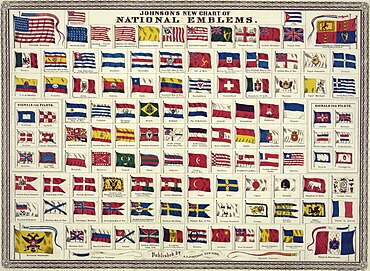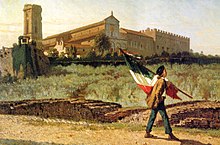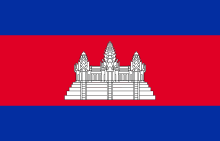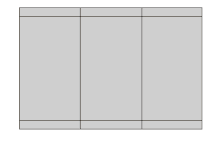
A flag is a piece of fabric with a distinctive design and colours. It is used as a symbol, a signalling device, or for decoration. The term flag is also used to refer to the graphic design employed, and flags have evolved into a general tool for rudimentary signalling and identification, especially in environments where communication is challenging. Many flags fall into groups of similar designs called flag families. The study of flags is known as "vexillology" from the Latin vexillum, meaning "flag" or "banner".

The Union Jack or Union Flag is the de facto national flag of the United Kingdom. The Union Flag was also used as the official flag of several British colonies and dominions before they adopted their own national flags. The flag continues to have official status in Canada, by parliamentary resolution, where it is known as the Royal Union Flag.

The national flag of France is a tricolour featuring three vertical bands coloured blue, white, and red. It is known to English speakers as the Tricolour, although the flag of Ireland and others are also known as such. The design was adopted after the French Revolution, where the revolutionaries were influenced by the horizontally striped red-white-blue flag of the Netherlands. While not the first tricolour, it became one of the most influential flags in history. The tricolour scheme was later adopted by many other nations in Europe and elsewhere, and, according to the Encyclopædia Britannica has historically stood "in symbolic opposition to the autocratic and clericalist royal standards of the past".

The national flag of Germany is a tricolour consisting of three equal horizontal bands displaying the national colours of Germany: black, red, and gold. The flag was first sighted in 1848 in the German Confederation. The flag was also used by the German Empire from 1848 to 1849. It was officially adopted as the national flag of the German Reich from 1919 to 1933, and has been in use since its reintroduction in Federal Republic of Germany in 1949.

The national flag of Sweden consists of a yellow or gold Nordic cross on a field of light blue. The Nordic cross design traditionally represents Christianity. The design and colours of the Swedish flag are believed to have been inspired by the present coat of arms of Sweden of 1442, which is blue divided quarterly by a cross pattée of gold. Blue and yellow have been used as Swedish colours at least since Magnus III's royal coat of arms of 1275.

The Flag of Finland, also called siniristilippu, dates from the beginning of the 20th century. On a white background, it features a blue Nordic cross, which represents Christianity.

The national flag of Romania is a tricolour. The Constitution of Romania states that "The flag of Romania is tricolour; the colours are arranged vertically in the following order from the flagpole: blue, yellow, red". The flag has a width-length ratio of 2:3; the proportions, shades of colour as well as the flag protocol were established by law in 1994, and extended in 2001. Its similarity to the flag of Chad has caused international discussion.

The national flag of Slovenia features three equal horizontal bands of white (top), blue, and red, with the coat of arms of Slovenia located in the upper hoist side of the flag centred in the white and blue bands. The coat of arms is a shield with the image of Mount Triglav, Slovenia's highest peak, in white against a blue background at the centre; beneath it are two wavy blue lines representing the Adriatic Sea and local rivers, and above it are three six-pointed golden stars arranged in an inverted triangle which are taken from the coat of arms of the Counts of Celje, the great Slovene dynastic house of the late 14th and early 15th centuries.

The national flag of Poland consists of two horizontal stripes of equal width, the upper one white and the lower one red. The two colours are defined in the Polish constitution as the national colours. A variant of the flag with the national coat of arms in the middle of the white fess is legally reserved for official use abroad and at sea. A similar flag with the addition of a white eagle is used as the naval ensign of Poland.

The flag of Serbia, also known as the Tricolour, is a tricolour consisting of three equal horizontal bands, red on the top, blue in the middle, and white on the bottom, with the lesser coat of arms left of center. The same tricolour, in altering variations, has been used since the 19th century as the flag of the state of Serbia and the Serb people. The current form of the flag was adopted in 2004 and slightly redesigned in 2010.

The national flag of Italy, often referred to in Italian as il Tricolore, is a tricolour featuring three equally sized vertical panels of green, white and red, with the green at the hoist side, as defined by article 12 of the Constitution of the Italian Republic. The Italian law regulates its use and display, protecting its defense and providing for the crime of insulting it; it also prescribes its teaching in Italian schools together with other national symbols of Italy.

The national flag of Croatia or The Tricolour is one of the state symbols of Croatia. It consists of three equal size, horizontal stripes in colours red, white and blue. In the middle is the coat of arms of Croatia.

The national flag of the Russian Federation is a tricolour of three equal horizontal fields: white on the top, blue in the middle, and red on the bottom. It was first raised in 1696, as an ensign for merchant ships under the Tsardom of Russia.

The national flag of Hungary is a horizontal tricolour of red, white and green. In this exact form, it has been the official flag of Hungary since 23 May 1957. The flag's form originates from national republican movements of the 18th and 19th centuries, while its colours are from the Middle Ages. The current Hungarian tricolour flag is the same as the republican movement flag of the United Kingdom and the colours in that form were already used at least since the coronation of Leopold II in 1790, predating the first use of the Italian Tricolour in 1797.

The flag of Portugal is the national flag of the Portuguese Republic. It is a rectangular bicolour with a field divided into green on the hoist, and red on the fly. The lesser version of the national coat of arms of Portugal is centered over the colour boundary at equal distance from the upper and lower edges. Its presentation was done on 1 December 1910, after the downfall of the constitutional monarchy on 5 October 1910. However, it was only on 30 June 1911, that the official decree approving this flag as the official flag was published. This new national flag for the First Portuguese Republic, was selected by a special commission whose members included Columbano Bordalo Pinheiro, João Chagas and Abel Botelho. The conjugation of the new field color, especially the use of green, was not traditional in the Portuguese national flag's composition and represented a radical republican-inspired change that broke the bond with the former monarchical flag. Since a failed republican insurrection on 31 January 1891, red and green had been established as the colours of the Portuguese Republican Party and its associated movements, whose political prominence kept growing until it reached a culmination period following the Republican revolution of 5 October 1910. In the ensuing decades, these colours were popularly propagandised, green represented the hope of the nation and the colour red represented the blood of those who died defending it, this happened to endow them with a more patriotic and dignified, therefore less political, sentiment.

The flag of Iceland was officially described in Law No. 34, set out on 17 June 1944, the day Iceland became a republic. The law is entitled "The Law of the National Flag of Icelanders and the State Arms" and describes the Icelandic flag as follows:

The national flag of Lithuania consists of a horizontal tricolour of yellow, green, and red. It was adopted on 25 April 1918 during Lithuania's first period of independence from 1918 to 1940, which ceased with the occupation first by the Soviet Union, and then by Nazi Germany (1941–1944). During the post-World War II Soviet occupation, from 1945 until 1988, the Soviet Lithuanian flag consisted first of a generic red Soviet flag with the name of the republic, in 1953 that was changed to the red flag with white and green bands at the bottom.

The national flag of Spain, as it is defined in the Constitution of 1978, consists of three horizontal stripes: red, yellow and red, the yellow stripe being twice the height of each red stripe. Traditionally, the middle stripe was defined by the more archaic term of gualda, and hence the popular name la Rojigualda (red-weld).

The flag of Yugoslavia was the official flag of the Yugoslav state from 1918 to 1992. The flag's design and symbolism are derived from the Pan-Slavic movement, which ultimately led to the unification of the South Slavs and the creation of a united south-Slavic state in 1918.

The flag of Emilia-Romagna is one of the official symbols of the region of Emilia-Romagna, Italy. The flag shows the coat of arms adopted in 1989 in the variant with green writing and red bar on a white background.



















































